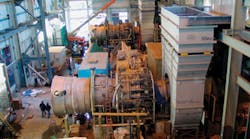New York City has outgrown the pace of its power production, and without new generating facilities, it could experience brownouts or blackouts in 2005, says Michael Lembo, president of the power group for Queens, N.Y.-based Slattery Skanska. To alleviate the city's increased power demands, a construction team is building one of the largest power plants in the history of the Big Apple — a 500MW combined cycle power plant in Astoria, N.Y.
The $650 million New York Power Authority Power Station will be located on the 50-acre Astoria Generating Site in the New York City borough of Queens, N.Y. Lembo says the new power plant will be the cleanest of the half dozen power plants that are operating on the site. A combustion turbine is designed to emit low levels of carbon dioxide, and the gas flows through a selective catalytic reactor, which keeps the exhaust clean. The new 500MW plant will replace the Charles M. Poletti Generating Station and cut airborne emissions in the borough by thousands of tons a year.
Slattery Skanska, the general contractor, has a $250 million contract to perform the civil, structural, electrical, and mechanical work on the project. The firm is also responsible for the installation, testing, and commissioning of all the equipment, including two heat recovery steam generators, two dual-fuel combustion turbine generators, and one steam turbine generator. Slattery Skanska awarded Long Island City, N.Y.-based E-J Electric Installation Co. a $50 million electrical contract to provide all the electrical and lighting services for the project. Richard Dominy, executive project manager and head of the power division for E-J Electric, says his firm arrived on the jobsite in February 2003 to provide 5kV temporary power; install the underground duct banks, conduit, cable tray, and switchgear; pull and terminate the cable; and install high-bay and incandescent lighting fixtures and the plant grounding systems.
About 150 electricians are currently working two eight-hour shifts from 7 a.m. to 3:30 p.m. and 4 p.m. to midnight to complete the project on time. E-J Electric started the double shifts in spring 2004 to successfully meet ConEdison's scheduled backfeed date of May 1, says Tony Mann, president of E-J Electric. The project is currently about 70% complete, and the construction team expects to wrap up the job by early 2005. Weather delays and the late arrival of the steel materials presented challenges in the earlier part of the project, and the team of more than 700 workers is now working together under a compressed schedule to get the job done.
The electricians are now working with about 550 other craftspeople to complete the construction of the three buildings on the property: a main building that houses the two gas turbines and a steam turbine; a gas compressor building where the natural gas is compressed for the gas turbines; and a chiller building that provides chilled water to cool the intake air to increase the output of the gas turbines. Because the power plant can't use significant amounts of water from the nearby East River, the facility is equipped with an air-cooled condenser, which uses 32 200-hp fans to condense the steam from the steam turbine.
The plant has 60 major systems, and before the project goes online, each system must be checked individually and then collectively to make sure they all work well together. Once completed, the plant will add 500MW of capacity to New York City's power supply system.
“The city has grown substantially and has a dire need for this power for next summer,” Lembo says. “This will be the largest power plant in New York City, and we feel good about the fact that 500MW doesn't get built every day.”
Sidebar: Electrical Needs by the Numbers
-
The number of electricians on-site at any given time will peak out at 200.
-
The electrical team will install 1.4-million linear feet of cable, 215,000 linear feet of conduit, and 26,000 linear feet of cable tray.
-
The plant will include 110,000 linear feet of process piping, 500 monitoring instruments, a one-million gallon water tank, and a 32-cell, air-cooled condenser.
-
The plant's electrical system will include a digital control system and three step-up transformers.




